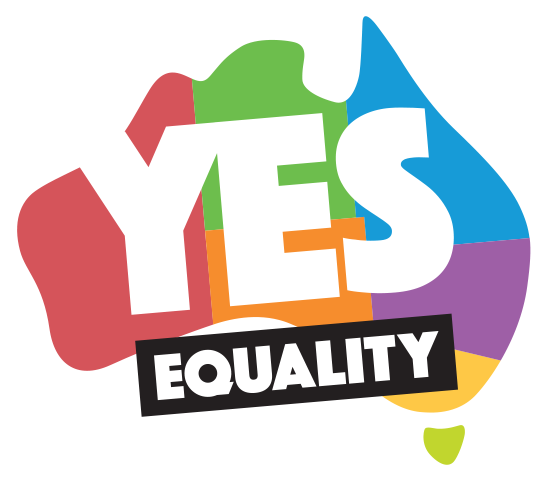The Road to YES
How Marriage Equality was Won Down Under
An original article by Lawrence Muskitta for sogicampaigns.org
David Kalisch had never been given so much attention. As Australia’s chief statistician, no one had ever had much reason to. But on the morning of 15 November 2017, the nation’s eyes were on him. Gathered en masse in parks and public spaces around the country or huddled around TVs and laptops in workplaces and living rooms, millions of Australians stood silent to listen to what he had to say.
This was the announcement of the Australian Marriage Equality postal survey, the $122 million national vote that no one wanted. Non-compulsory and non-binding, from a legislative perspective, this meant very little. But for the members of the LGBTIQ+ community who had had their lives and relationships publically scrutinised for the past three months, this was a fight we could not afford to lose.

This moment is not the start of the story. It’s not even the end. For those who were in it, this was the emotional epicentre.
For me, I was in Sydney’s Prince Alfred Park with a thousand other YES campaign supporters. It was a Wednesday. I was standing with my best friend Flora and her girlfriend Liz. We had all taken the morning off work to be here. Flora hasn’t slept much last night, she told me. Neither had I.
Beside us, a gaggle of young gays take selfies and compare their outfits. On the other side, an older lesbian couple tie a rainbow sash around their kelpie’s collar. Simmering under the smiles and festivities, however, is a deep solemness. We all feel it. It’s not just the anticipation of the upcoming result, it’s an acknowledgement of the ordeal we had all just endured together.
Three months of hateful or ignorant comments on social media, of attack ads on repeat, of homophobes getting a national platform for the sake of “balanced debate”, of unsolicited opinions in the lunch room – it would all end. We were tired of being angry.
That’s when David comes on screen. We all immediately tense. Flora wraps her arm around me and I hold Liz’s hand. The air is silent.
How did we get here? The road to marriage equality is never straightforward. In Australia, however, it could have been a hell of a lot smoother. Before the postal survey, support for marriage equality was consistently in the high-60s, the two leaders of our major parties personally supported the cause, and our Parliament, if allowed a free vote on the issue, would have passed it without a sweat. So why did it take so long and how did it come to this?
Some history
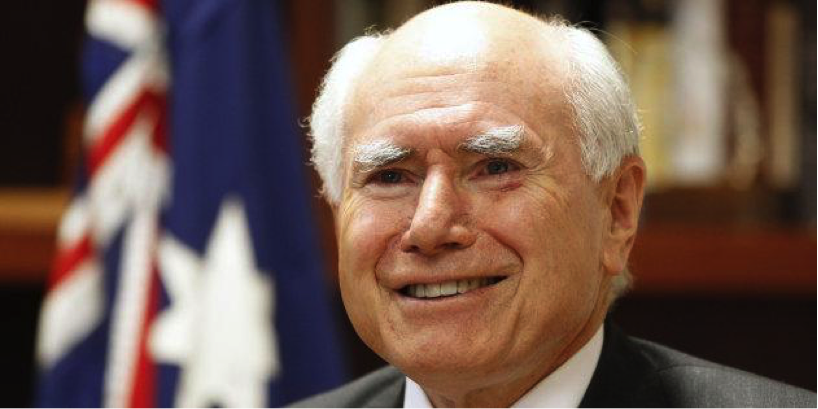
The year is 2004. Marriage equality is starting to become a real possibility worldwide. Massachusetts and parts of Canada had just legalised same sex marriage earlier in the year, Belgium the year before and the Netherlands two years before that.
The Australian Prime Minister at the time is John Howard, a centre-right conservative who leads the inexplicably named Liberal Party. Howard is known to be a devout man who goes to church every Sunday, quite publically, with his wife Janette. His political base is the suburban middle-class, predominately white and strictly socially conservative.
Legislatively, Australian marriage law is governed by the Marriage Act 1961, which in itself did not have an explicit definition for marriage. It instead borrowed it from the British common law case Hyde v Hyde (1866).
In an attempt to hold back the rising tide for same sex marriage and “protect the institution of marriage”, Howard amended the legislation to include the following:
Marriage means the union of a man and a woman to the exclusion of all others, voluntarily entered into for life.
A union solemnised in a foreign country between:
(a) a man and another man; or
(b) a woman and another woman;
must not be recognised as a marriage in Australia.
It passed through Parliament with the support of the Opposition (the Australian Labor Party) with the Australian Greens and the Democrats opposing.
This explicit ban against same sex marriage was the catalyst the LGBTIQ+ community needed and, from it, the Australian Marriage Equality (AME) campaign was born.
Together with groups like GetUp! and Community Action Against Homophobia (CAAH), they built a grassroots movement to mobilise support for same sex marriage, first within the LGBTIQ+ community, then to wider society.
This proved incredibly effective, with support for same sex marriage increasing from 38% in 2004 to 57% in 2007, an increase of over 19% in under three years.
But despite this sweeping social change, legislative reform requires political will – something which wouldn’t come for many years yet.
The politics
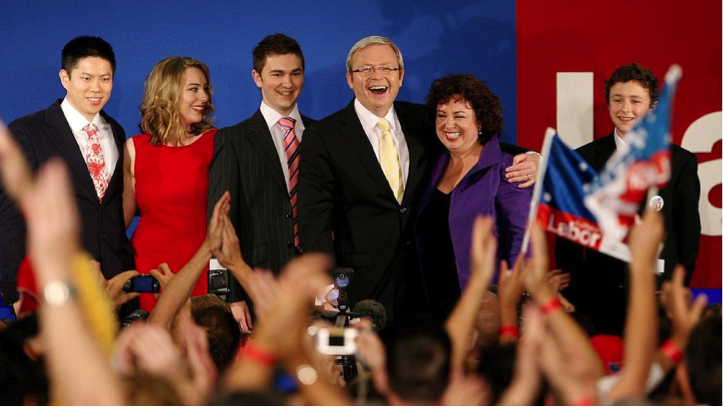
To say that the political situation between 2007 and 2017 was tumultuous would be an understatement. In this time, we had two changes of government, five Prime Ministers and six leadership changes.
In 2007, Labor’s Kevin Rudd won a landslide victory, unseating the 11-year Howard Government. With a progressive reformist agenda, it seemed there was hope for same sex marriage to be on the agenda.
However, as the years passed, this hope began to dwindle. Rudd, it seemed, was just as conservative as his predecessor in the issue. And politically, as his polls began to slip, he needed to retain the all-important swing seats in Queensland and Western Sydney to keep hold of power – two of the least queer-friendly regions in the country.
Even though the Greens proposed more than five separate bills on the issue during his tenure, a combination of the Prime Minister’s personal position and the Government’s political calculus meant they were all doomed to fail.
In 2010, after a bloody and unexpected leadership spill, Rudd’s deputy Julia Gillard took on the Prime Ministership. After an election later that year, she returned to power with a minority Government, formed with the support of three independent MPs – all from rural Australia.
In what was probably the most frustrating time for the movement politically. We now had a Prime Minister who, by all accounts, personally supported reform but was so hamstrung by the Parliamentary numbers-game, she had to publicly say she was against it.
In 2011, after a strong public campaign, the Labor party national conference voted to change their party platform in support of same sex marriage, allowing MPs a free vote on the issue.
The year after, a joint-party bill was put before Parliament. It was decidedly voted down 98-42, a combination of Liberal MPs being bound to vote against and almost half of the Labor MPs voting no.
This put the issue to bed til the rest of Gillard’s tenure, which only lasted another year until she was ousted by her predecessor, Kevin Rudd.
Rudd took the party to the election, promising marriage equality within the first 100 days of his new Government. He was electorally crushed by conservative heavyweight Tony Abbott.
When Abbott became Prime Minister he promised a plebiscite on the issue of marriage equality, a binding national vote on a piece of legislation. Abbott did not act on this promise for the length of his tenure.
Before Abbott could finish his first term, however, he was disposed of by his moderate Communication Minister Malcolm Turnbull, who won the Prime Ministership with the support of several conservative MPs.
Turnbull was a strong public supporter of marriage equality but was now hamstrung by his conservative party room allies and the commitments the Abbott government had already made.
Labor and the Greens were against a national plebiscite, preferring a free vote so as not to subject the LGBTIQ+ community to unwarranted public scrutiny or persecution. So when the bill for a plebiscite was presented, they blocked it in the Senate.
Wedged between the mounting public pressure and the conservatives in his party room, Turnbull asked the Bureau of Statistics to conduct a national postal survey. It would be non-binding and non-compulsory. Basically, a very expensive poll, which even if passed would have no legislative effect.
This is where the AME movement splintered. Half of the group wanted to oppose the postal survey on constitutional grounds, the other half wanted to just get it over with.
The AME mounted a legal case against the postal survey on two fronts: the effect it would have on the LGBTIQ+ community, and the legality of the appropriation of funds. Both were struck down by the High Court.
The postal survey begins
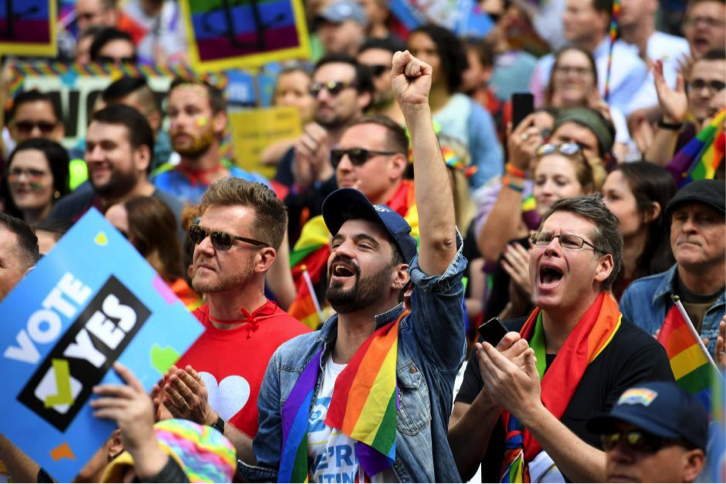
After the High Court ruling, the Equality Campaign partners had to come together. It was on, and there was too much at stake for in-fighting.
Under campaign director Tiernan Brady, the preparations had been made, the battlelines drawn, troops rallied – we were going to war.
Research
The Equality Campaign conducted extensive quantitative and qualitative research both before and during the Equality campaign.
Quantitative polling on the issue showed us three main things:
- If everyone who could vote did vote, the YES campaign would comfortably win
- People most likely to vote YES were younger people, women and people who live in the inner cities
- Young people, who represent a large segment of the YES vote, are less likely to vote
Similarly, on a qualitative level, the main insights were:
- Most people had fixed view on the issue and saw their vote as a personal choice
- The most convincing arguments weren’t arguments at all, they were stories, especially from people they knew or people who were “like them”
- If the question was framed around fairness, undecided people were more likely to agree, compared to if it was framed around rights or entitlement
Strategy
From this base of research, the campaign strategy was simple:
- Focus on getting our supporters to post their ballots
- Convince the undecided using personal stories
- Stay relentlessly positive and on-message
From a resourcing perspective, the first point was vitally important. Although there was a lot of work done to engage with more hard-to-reach populations like culturally and linguistically diverse (CALD) people, people of faith and people in rural and regional Australia, most of the on-the-ground activities happened in areas where we knew we had strong support.
The storytelling element was a cornerstone of the campaign. Over the course of the campaign, we received more than 12,000 stories from individuals. This took a whole team to shift through these stories and turn them into materials for social, advertising and earned medias.
The last point of relentless positivity was probably the most difficult. With an opposition whose primary strategy was fear-mongering and distraction, it would have been too easy to get caught in a mud fight. This message discipline was not only for the sake of campaign effectiveness, it was also important for the wellbeing of our supporters. As the campaign ground on, we wanted to continue to inspire our supporters with messages of hope and fairness.
The advantage of having such a structured electoral process is that campaign’s critical path was also clear. The month of August was focused on creating visibility for the campaign, building lists and infrastructure, and getting young people to register to vote. In September, when the ballots begin to arrive, was the battle for hearts and minds, on earn, social and paid media. October was the height of the campaign, when it hit media saturation, so we focused on on-the-ground and face-to-face activities, reminding supporters to post their ballots and giving them all the help they’d need to do so. November was the final push and a pivot towards government relations – turning a potential YES vote into a legislative reality.
Digital
Digital was the very backbone of the campaign.
The website alone was visited by more than 1.45 million people. Built on a NationBuilder infrastructure, the campaign used simple forms to make sign up and getting involved as simple as possible.
From there, an automated email journey segmented this list by level of engagement based on email opens and subsequent actions taken. These included things like sharing their story, signing up to volunteer and donating.
This segmentation was then later used for prioritising on-the-ground activities and building profiles for digital advertising.
One online action that worked particularly well was the postbox lookup and post reminder. In it, people could find where their nearest postbox is and set themself a reminder to post their ballot at a certain time and date. This not only educated supporters and gave them a prompt to action, it also added a more specific geographic element to their profile, which was used to again enrich the on-the-ground and digital advertising datasets.

On the digital advertising front, the campaign ran over 33 million ads, targeted at 4.6 million likely YES voters. This meant that likely YES voters got up to seven reminders in a three week period to post their ballots.
By running a large range of adsets, using different messages, images and target profiles, the results of the digital advertising essentially acted as real-time content and audience testing. The best performing ads were then used as the basis of print and outdoor advertising, and the strongest performing messages used in TV ad scripts and earned media.
The text message that came from a phone user titled YesEquality read: “The Marriage Equality Survey forms have arrived! Help make history and vote YES for a fairer Australia. VoteYes.org.au.”
Somes shared the text on social media, complaining about it being an invasion of their privacy, but this phenomenon is likely to have been exagerated by the NO side, as it played into their narratives that the YES side was having a strategy to bully and intimidate their opponents.
Social
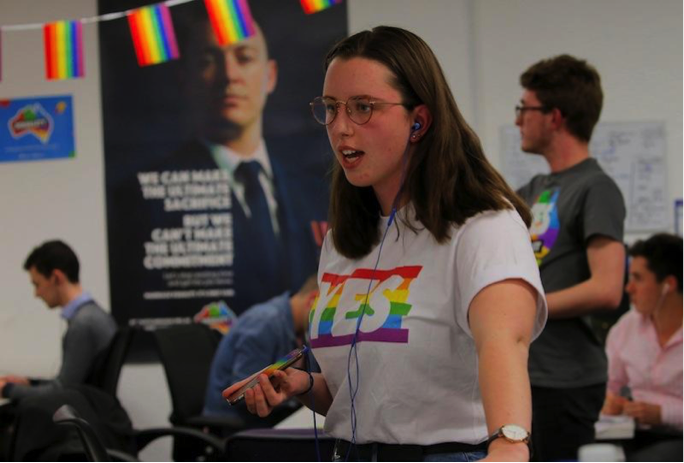
The YES campaign used social media to amplify our messages and empower supporters to tell their stories.
The mantra of relentless positivity was crucially important when it came to the social media space. Where our supporters’ newsfeeds were being clogged with outrage and negativity, the social media team tried to sprinkle a bit of happiness. Whether it’s a GIF of puppies or a video about an older gay couple who have been together for 30 years, the content always aimed to uplift.
One of the most effective social media tactics that was used was #RingYourRelos. This was an action that asked supporters to film themselves calling a relative, asking them to vote YES. The result was astounding, with hundreds of people submitting their videos, many of them ranging from heartwarming to ugly-cry inspiring.
Organising
Using the organising infrastructure of campaign partners, the campaign was able to mobilise large groups of people in a very short period of time.
In the end, the campaign engaged more than 15,000 volunteers, knocked on over 100,000 doors and made more than 1 million phone calls.
This was down to the hard work and expertise of field organisers across the country, many of whom were seconded from NGOs and the union movement.
The initial list segmentation done through the web-actions made it easy for organisers to identify and tag highly engaged supporters.
Although doorknocking data was inputted manually, this also provided invaluable insights into how different areas were going to vote on the issue. Overlaid with the electoral roll and census data, this then fed back into how we planned future on-the-ground activities and also how we targeted both digital and traditional advertising.
As well as the grassroots organising, campaigners also organised public marches that drew more than 20,000 people in Sydney alone. These were amongst some of the biggest public rallies in Australia’s history.
Earned media
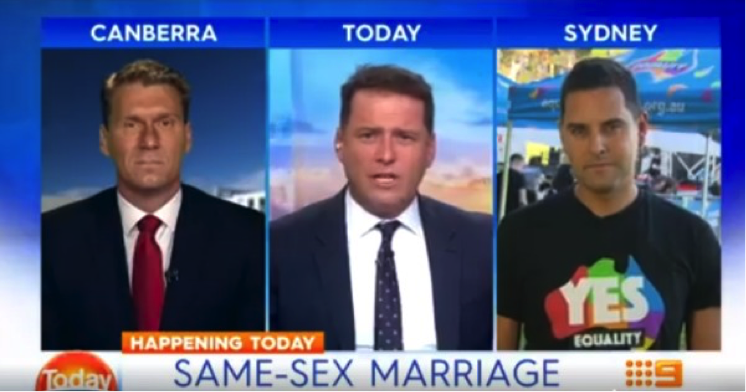
It’s often said “A lie can travel halfway around the world while the truth is putting on its shoes.”
The YES campaign’s message discipline and relentless positivity worked to unify supporters but did little to get us airtime and column inches.
According to a report by the Guardian, during the campaign, lead NO campaigner Lyle Shelton was mentioned across news outlets more times than the leading three YES campaigners, Alex Greenwich, Tiernan Brady and Sally Rugg, combined.
Media loves conflict and the NO campaign had a lot of conflict to give. While we were flogging stories about gay cowboys and lesbian mums, the other side were heralding a doomsday where schoolboys were forced to wear dresses, people of faith were persecuted for their beliefs and Australian larrikinism was strangled by lefty political correctness.
Fundraising
The YES campaign’s online fundraising effort brought in over $1.2 million from separate donors 11,000 donors. In contrast, the NO campaign reportedly raised over $6 million from over 20,000 donors.
There are a couple reasons for this discrepancy. Firstly, as mentioned, the demographic of YES supporters skews significantly younger and therefore has less disposable income for donations. Secondly, the YES campaign’s commitment to being relentlessly positive may have inhibited its fundraising effectiveness. As the fundraising team themselves explain, one of the most powerful motivators for political donating is anger or fear. These more negative approaches worked well with the NO campaign’s messaging but was not something we were willing to espouse in our supporters.
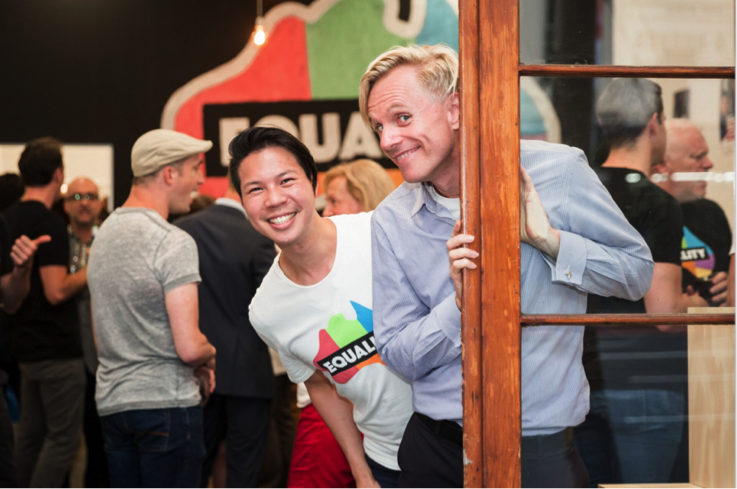
More positively, the YES campaign merchandise was a smash hit. In all, the campaign sold more than 52,000 items, including t-shirts, badges and beach towels.
The moment
We’re back in Prince Alfred Park. David Kalisch is on screen. Not to waste his time in the sun, he has been talking for four minutes about the rigour of their statistical methodology. All eyes are glazed over.
“Now the official results of the Australian marriage law postal survey…”
A pause. Everyone has suddenly woken up. Liz tightens her grip on my hand. We hold our breaths.
“For the national result, Yes responses, 7,817,247, representing 61.6 per cent.”
The crowd erupts. We don’t need to hear more. We had won.
A great insight from Tiernan Brady, one of the leaders of the Equality Campaign (and yes, he is the one who was also one the leaders of the Irish Yes Equality campaign!): “I always think about three animals when I’m campaigning: don’t eat red herrings, don’t run down rabbit holes and never mud wrestle with a pig because the pig loves it and all you get is muddy.”
BONUS
The Yes campaign site brings the campaign’s story in a snappy colorful format, which is a great example of campaign reporting ! Go have a look and get more inspiration!

